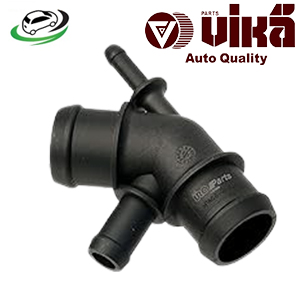-25%
Get Upper Radiator Coolant Hose Distributor Flange AUDI TT MKI 180HP/225HP / VW Golf IV-1.8T/2.0/TDI/Jetta IV-1.8T/2.0/TDI 1J0121087C
The radiator coolant hose distributor flange is a critical component in a vehicle’s cooling system. It plays an essential role in managing the flow of coolant between the engine and the radiator, ensuring the engine remains at an optimal operating temperature. This comprehensive guide covers the design, function, types, benefits, maintenance, and replacement of the radiator coolant hose distributor flange.
Design and Function
Design:
The radiator coolant hose distributor flange typically consists of:
- Flange Body: Made from materials such as aluminum, steel, or high-strength plastic, the flange body is designed to withstand high temperatures and pressures.
- Hose Connections: Multiple ports for connecting various coolant hoses, allowing the distribution of coolant to different parts of the engine.
- Sealing Surface: A smooth, flat surface where the flange meets the engine block, often sealed with a gasket or O-ring to prevent leaks.
- Mounting Holes: Holes or brackets for securely attaching the flange to the engine or other components.
Function:
The primary functions of the radiator coolant hose distributor flange are:
- Coolant Distribution: Directs coolant from the radiator to the engine and back, ensuring efficient heat exchange and preventing overheating.
- Sealing: Provides a tight seal to prevent coolant leaks, maintaining the system’s pressure and efficiency.
- Connection Point: Serves as a junction for multiple hoses, simplifying the routing and organization of the cooling system.
Types of Radiator Coolant Hose Distributor Flanges
1. Single-Port Flange:
- Description: Features one hose connection, typically used in simpler cooling systems.
- Application: Suitable for smaller engines or systems with straightforward coolant routing.
2. Multi-Port Flange:
- Description: Contains multiple hose connections, allowing the distribution of coolant to various parts of the engine.
- Application: Common in modern engines with complex cooling requirements.
3. Thermostat Housing Flange:
- Description: Integrates a thermostat within the flange to regulate coolant flow based on temperature.
- Application: Used in systems where precise temperature control is necessary.
4. Custom Flanges:
- Description: Designed for specific applications, often featuring unique shapes or additional ports.
- Application: Used in performance or modified vehicles where standard flanges are not sufficient.
Benefits
1. Efficient Coolant Distribution:
- Optimal Temperature Regulation: Ensures that coolant is distributed evenly throughout the engine, maintaining a consistent temperature and preventing hot spots.
- Improved Performance: Helps the engine operate efficiently, enhancing performance and fuel economy.
2. Leak Prevention:
- Secure Sealing: Prevents coolant leaks, maintaining system pressure and preventing overheating.
- Longer Component Life: Reduces the risk of coolant loss, which can lead to engine damage and costly repairs.
3. Simplified Maintenance:
- Easy Hose Connections: Multiple ports allow for straightforward connection and routing of hoses, simplifying maintenance and repairs.
- Versatility: Can be used in a variety of engine configurations, making it a versatile component in the cooling system.
4. Durability and Reliability:
- High-Quality Materials: Made from robust materials designed to withstand high temperatures and pressures, ensuring long-term reliability.
- Resistance to Corrosion: Many flanges are treated or coated to resist corrosion, extending their lifespan.
Maintenance and Troubleshooting
1. Regular Inspection:
- Visual Check: Inspect the flange and connected hoses for signs of wear, cracks, or leaks. Look for coolant stains or wet spots around the flange.
- Seal Condition: Check the gasket or O-ring for signs of deterioration, such as cracking or hardening.
2. Symptoms of a Failing Distributor Flange:
- Coolant Leaks: Visible coolant leaks around the flange area indicate a potential sealing issue.
- Overheating: If the engine overheats frequently, it could be due to insufficient coolant distribution caused by a damaged flange.
- Low Coolant Levels: Constantly low coolant levels without visible leaks may indicate a leak at the flange.
- Pressure Loss: A drop in system pressure can suggest a failing flange, affecting coolant flow.
3. Replacement Procedure:
- Preparation: Gather necessary tools and a replacement flange. Ensure you have the correct part for your specific vehicle model.
- Drain Coolant: Begin by draining the coolant to prevent spills during the replacement process.
- Remove Old Flange: Disconnect the hoses and remove the mounting bolts to take off the old flange. Carefully clean the sealing surface on the engine block.
- Install New Flange: Place a new gasket or O-ring on the flange, then attach it to the engine block. Secure it with the mounting bolts, ensuring an even, tight fit.
- Reconnect Hoses: Reattach the coolant hoses to the new flange, ensuring all connections are tight and secure.
- Refill Coolant: Refill the cooling system with the appropriate coolant and bleed any air from the system.
- Test for Leaks: Run the engine and check for any signs of leaks around the new flange.
4. Professional Inspection:
- Mechanic Inspection: If you suspect an issue with the distributor flange, have a professional mechanic inspect it. They can accurately diagnose the problem and ensure proper replacement.
- Pressure Testing: A mechanic can perform a pressure test on the cooling system to identify any leaks or pressure drops, confirming the integrity of the flange and related components.
Seasonal Considerations
1. Winter:
- Cold Weather Effects: Low temperatures can cause seals and hoses to become brittle, increasing the risk of leaks. Regularly inspect the flange during winter months.
- Coolant Type: Ensure the coolant used is suitable for winter conditions, providing adequate freeze protection.
2. Summer:
- Heat Exposure: High temperatures can accelerate wear on the flange and hoses. Inspect the cooling system more frequently during summer months.
- Cooling System Load: High ambient temperatures increase the cooling system’s load, making it essential to ensure all components, including the distributor flange, are in good condition.
Follow us on Facebook for more parts.



